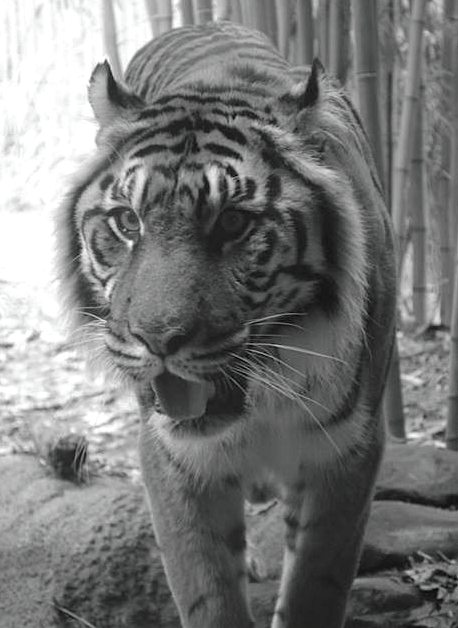

Photo Credit / Rebecca Carroll
By Briana Magistro
SC Staff Writer
With its bright orange coat painted with black stripes, the Bengal tiger is one of the most easily distinguishable big cats.
The big cat classification is not biologically official, but it is a popular specification. The group includes other carnivorous, heavy cats, like the lion and cougar.
The Bengal tiger exhibits a signature orange coat, which can range from light peach to a burnt sienna. It is also covered in dark stripes, which are typically brown or black in color.
Sporting a unique coat, the white Bengal tiger’s coloration is not as uncommon as you may think. There have been many accounts of white tigers in nature. Their stripes are usually black or faded brown in color.
In captivity, many white tigers are bred together to produce more white tigers, as the gene for white hair is recessive.
This is purely for aesthetic purposes, as a white coat does not give the tiger any advantages. In fact, without its orange and black camouflage, a white tiger is more likely to be spotted in nature, and it may be poached more easily.
It is important to note that the white coloration is not albinism.
These tigers are sometimes confused with another popular tiger, the Siberian tiger. These animals differ in size and head shape, the Siberian tiger being larger in both of these. The Siberian tiger also has denser and lighter colored fur, which helps it to cope with and blend in with its tundra climate. In captivity, there have been hybrids of these two tigers.
The Bengal tiger is the most populous of the tigers, and in the wild they live in various spaces around India and southwestern Asia, including Bangladesh. They prefer dense or tropical forests, as well as mangroves and grasslands with ample tree coverage.
With humans constantly expanding into tiger territory, tiger sightings have become more common. Habitat loss is the leading cause of wild tiger population decline.
These tigers are massive and need a large territory to support their hefty diet. They can grow to over 10 feet long and can weight over 500 pounds. Being so large, they do not have to be careful about what they prey upon.
Their diet consists of mostly hoofed animals, like antelopes, as well as mid-size boars. They will also hunt smaller prey, like birds. In uncommon circumstances, tigers will even prey upon other hunters, like jackals or leopards. In extreme cases, tigers have been documented stalking elephants.
Tigers that live near encroaching human civilization may even eat livestock for dinner. Also due to human advances, there have been a few instances of man-eating. People living in these areas have become accustomed to tiger encounters and take precautions to avoid attacks.
Due to their need for a large area for hunting, Bengal tigers are very territorial. Only one adult will live in a territory for the purpose of sustainability. However, their territories tend to overlap with tigers of the opposite gender at the borders. This is to promote reproduction, which is non-seasonal.
Cubs are born after a fivemonth gestation period. They reach maturity at around three years of age and move out of their mother’s territory when they are between two and five years old.
An interesting fact about some of the big cats is that some of them can roar and some of them can purr. Tigers and lions are able to roar due to an adaptation in their larynxes. Cougars and cheetahs purr instead of growling and are more closely related to the house cat.
Tigers are often associated with water. Their tropical habitats tend to have a lot of water features, especially in the mangroves. Bengal tigers have been known to cool off and have fun in water features. Not all cats are afraid of water!
Bengal tigers are endangered. Loss of habitat due to human urbanization is the biggest contributor to the tiger population decline. Poaching is also a leading factor.
Although there are plenty of tiger reserves throughout Asia and India, many poachers enter these protected areas and illegally hunt tigers.
Tiger bones are used in many traditional Asian medicines, and their coats are worth a lot of money. Tigers are also being traded internationally in the exotic animal trade.
The closest zoo to see this wonderful creature is at Claws N Paws in the Poconos. This zoo has a white Bengal tiger on display.
To keep these beautiful creatures from going extinct, we must protect them.
Please support the conservation of these animals. Do not buy any items made from tiger bone or fur, and do not support any entertainment which features an illegally traded tiger.
Email Briana at:
bmagistro@live.esu.edu
